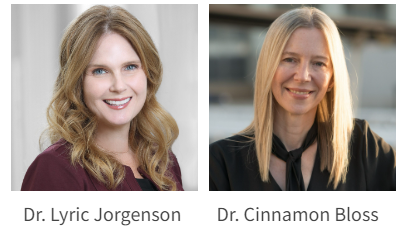Dr. Lyric Jorgenson has co-authored this blog with Dr. Cinnamon Bloss (r). Dr. Bloss is a Professor and Assistant Dean of Academic Affairs at the Herbert Wertheim School of Public Health and Human Longevity Science at the University of California, San Diego (UCSD). Dr. Bloss also serves as the Chairwoman of the Novel and Exceptional Technology and Research Advisory Committee (NExTRAC).
Effective policy is built on a trust, but trust means different things to different people, and the very thing that makes you trustworthy to some, might cause suspicion in others. The only way to really understand these different assumptions is to talk to people who may have different views to understand their priorities. As such, it is critical to engage a diverse array of members of the public to hear their thoughts when undertaking policy development.
To gain perspective on how people view the novel use of their personal data for biomedical research, the NIH added a key element to the Novel and Exceptional Technology and Research Advisory Committee (NExTRAC) charge to engage diverse communities about their views. The topic of data science seemed especially appropriate for public engagement, since almost everyone has some type of smart device on them at any given time. From a research perspective, the data obtained from these technologies represents a rich source of information that can be used to gain insights into individual and community health. However, it also raises questions about privacy and autonomy, as well as potential risks and benefits. All of these considerations lead to the central question of “what do people think about their data being used for research purposes?”
The NExTRAC Report on Data Science and Emerging Technology in Biomedical Research was approved at its latest meeting in August 2023. The report details the approach the Committee and NIH took to engaging the public in a series of community conversations, made possible by community partners and expert facilitators. They took place in diverse communities throughout the United States and involved discussion about the uses of personal health data in biomedical research. This process and the information obtained demonstrate the benefits of getting real-time feedback on specific topics of importance to a community. Overall, the conversations fostered rich, candid, bi-directional dialogue.
The report also describes the critical need for NIH to assist investigators in engaging with research participants and communities through honest and transparent dialogue early in and throughout the research process. To help realize that goal, the Committee recommended that NIH develop best practices for participant engagement on topics related to how their personal health data are being managed, reused, and linked to other data. These best practices would be especially important in situations where they extend beyond regulatory requirements.
The Committee also noted that members of the public want to see a return of value from their research participation. This would include, in some instances, the return of their research results. With this in mind, the NExTRAC recommended that NIH support further public engagement efforts to inform best practices for the return of research results to participants, and to explore methods for providing benefits and return of value beyond the return of research results.
Another vital recommendation by the Committee was that NIH should examine its funded portfolio of projects that address public engagement related to data science research and consider possible synergies, lessons learned, and ways to coordinate them, as appropriate. Such an effort could be valuable for investigators as they look to incorporate public engagement into their research efforts. We encourage you to read the NExTRAC’s report to get the full context of the Committee’s comments and recommendations.
While NIH has several ongoing efforts aligned with the NExTRAC’s recommendations, we know that more can be done. For example, while many of NIH’s Institutes and Centers have developed best practices for engaging with the communities they serve, it is useful to also take an agency-wide view on how best to support investigators in integrating engagement in their research. As another example, the NExTRAC notes that NIH has resources for drafting informed consent language, protecting research participant privacy, and responsible sharing of American Indian and Alaska Native participant data. However, more will be needed as the types of personal health data and practices for use and reuse of those data evolve. Additionally, to inform future policy frameworks on return of research results, NIH is supporting a contract to examine various aspects of responsibly returning individual research results to participants, and has solicited proposals aimed at developing an empirical evidence base for how environmental health results can be shared responsibly with participants. We look forward to considering additional next steps for returning individual research results.
Paradigm shifts like the one described in the Committee’s report take time. However, the roadmap laid out by the NExTRAC will help ensure that NIH makes continuous progress towards its mission of better health for all. Importantly, the lessons we learned from this engagement process can inform how we approach policy making in general. We know that relying only on requests for comment in Federal Register notices, or even expert workshops, are not enough when true engagement with members of the public is the goal. Additionally, public engagement takes time, and must be done thoughtfully and in partnership with communities. Through these efforts, NIH aims to build a model of public engagement for policy making that is based on transparency, accountability, respect, and trust.







